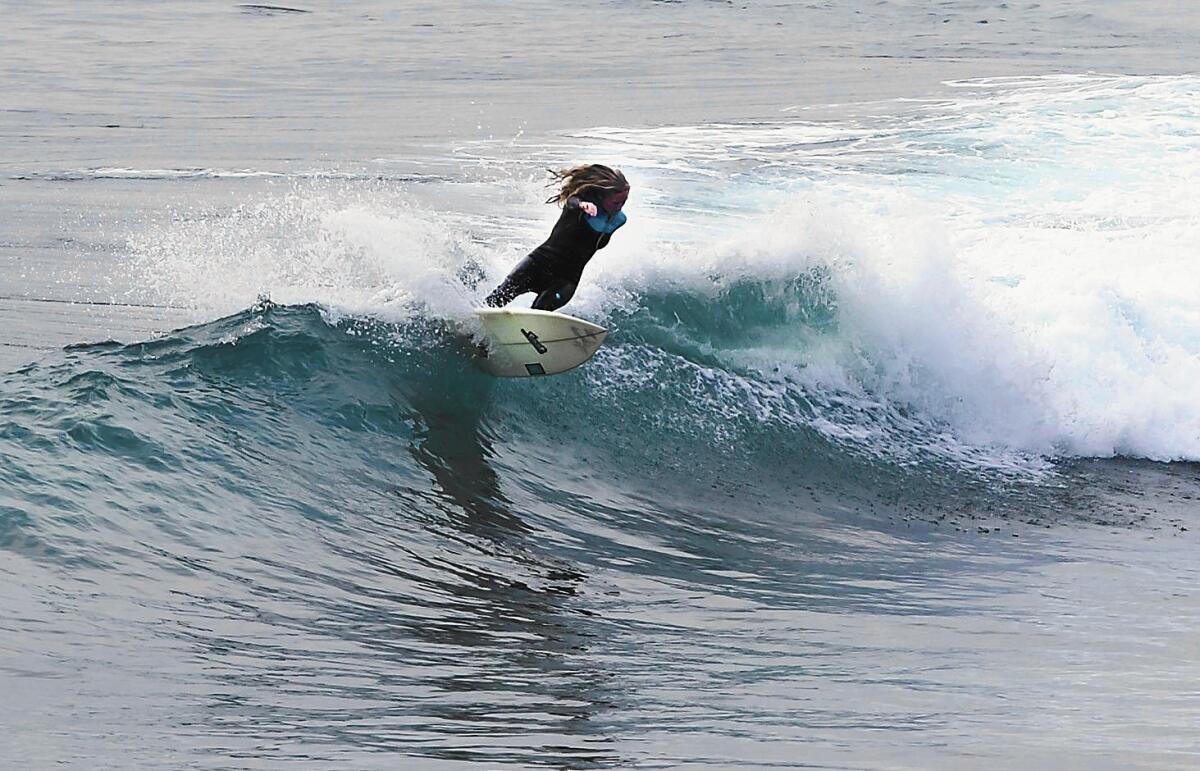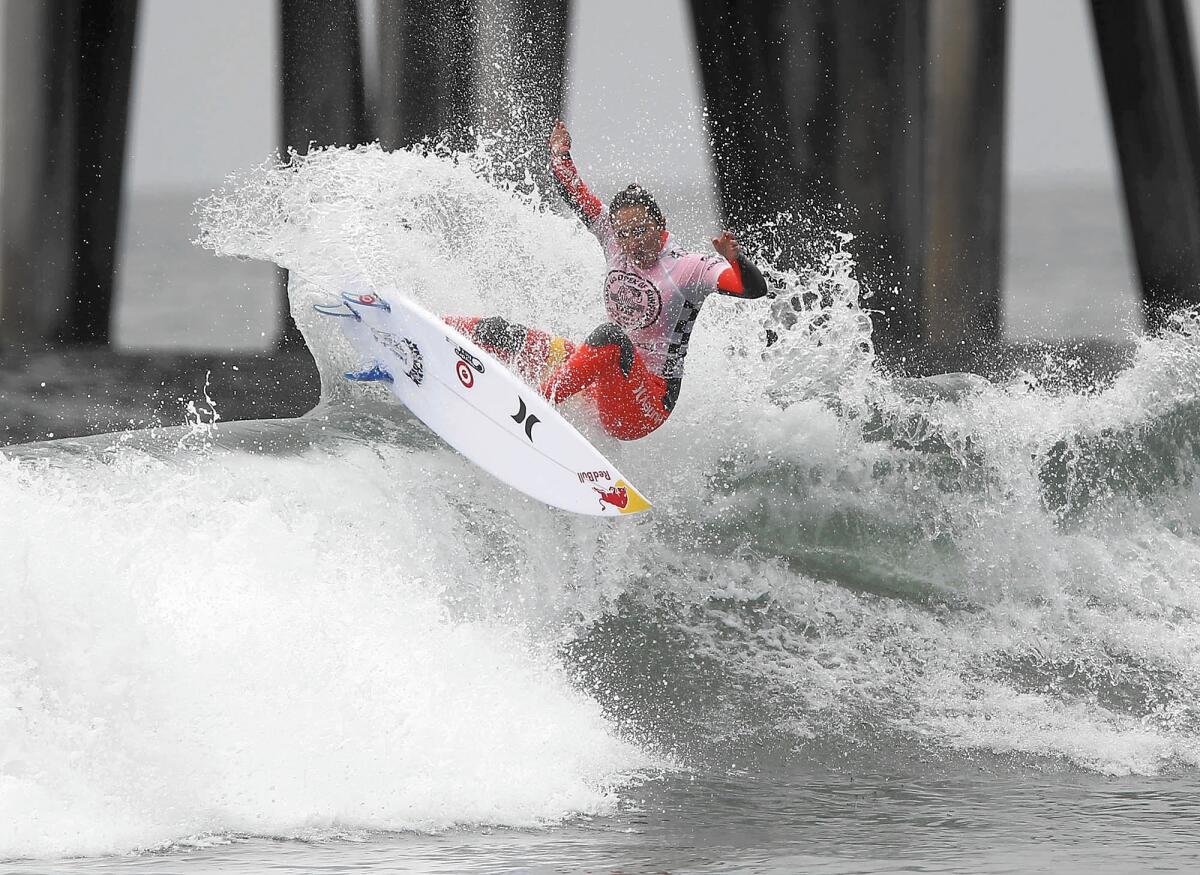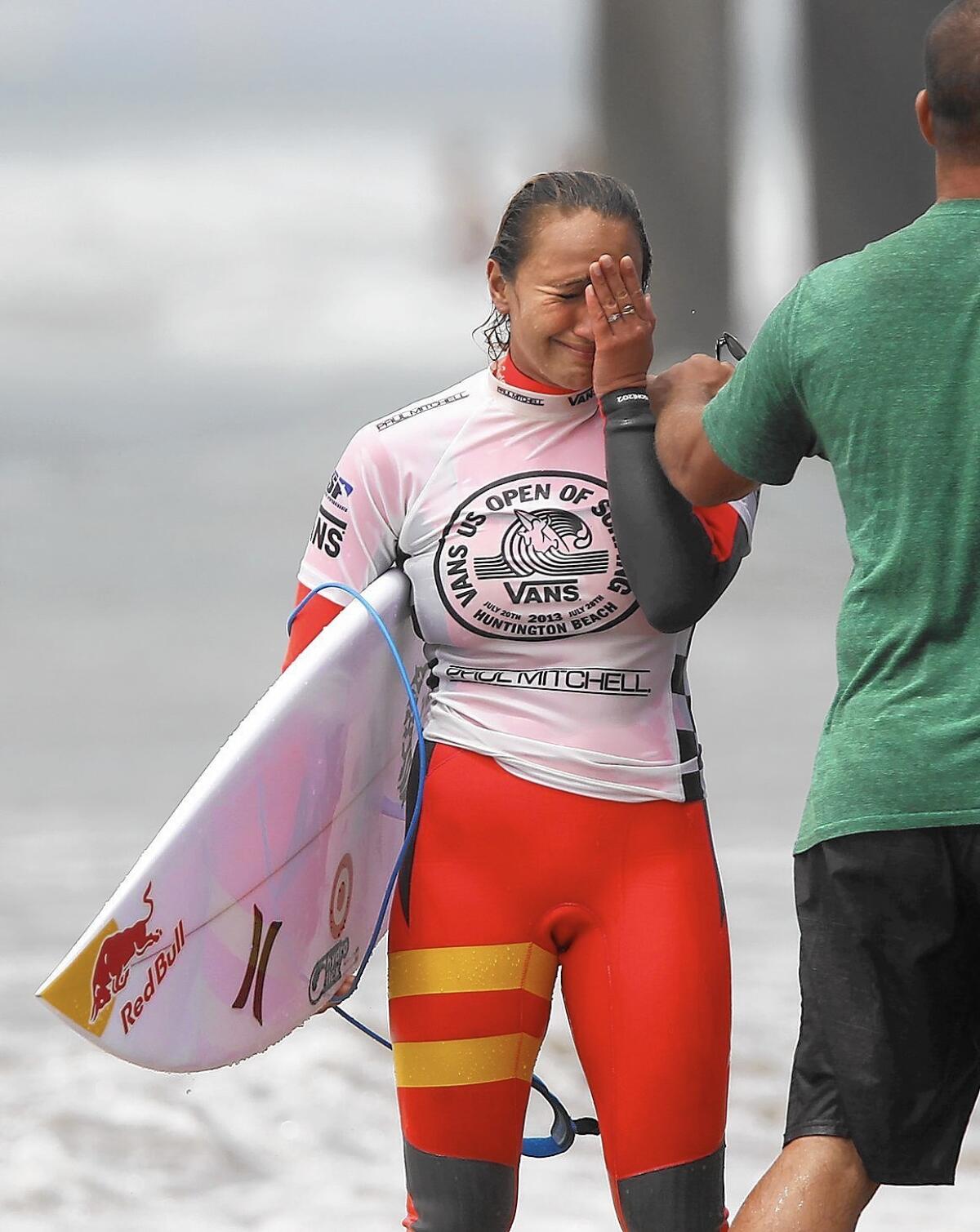Sexism in the surfing world: a mixed report

Alisa Schwarzstein, a pioneer in woman’s pro surfing and member of Surfing Walk of Fame, surfs during a recent session in Laguna.
- Share via
When Cathy Young was a teenager in the 1970s, she wanted to surf—but that’s not what girls were supposed to do back then.
“I had a teacher who said to me, ‘You can’t do that—that’s what boys do,’” the 53-year-old Huntington Beach resident recalled. “And I was like, ‘No, really I can!’ I didn’t realize at the time that she meant I couldn’t do it culturally.”
Now the 36-year surf veteran catches waves four times a week in the summer.
One thing she can’t help but notice is that there are a lot more women in the water today.
“The whole culture has changed,” said Young, who heads the Wahine Kai Surf Club for women. “Now it’s considered cool.”
While surfing has long been considered a male-dominated sport, women are now seeing more equality on the waves, from greater rates of women’s participation to the World Surf League committing to parity in prize money between the sexes.
At the same time, many women surfers still struggle with residual gender barriers.
“The sport has a long, fairly shameful history of sexism,” said Matt Warshaw, author of the Encyclopedia of Surfing. “And it’s still not over.”

Taylor Pitz, a former junior star from Laguna Beach, surfs at her home break in Laguna.
According to Warshaw, sexism was not always a part of surfing. “In ancient Hawaii,” he said, “queens surfed, and princesses surfed. It was just something everyone did.”
It wasn’t until modern times that the gender gap started to emerge.
In the early 20th century, wooden surfboards were long and heavy—measuring 15 feet long and weighing nearly 100 pounds—which prevented many women from taking up the sport.
But by the 1940s and 1950s, Malibu surfers developed “girl boards”—also known as the “Malibu chip”—made of balsa wood that were easier for women to handle, said Warshaw.
“As soon as these boards were handed out to the girls, the guys started borrowing them and taking them out to surf because they were smaller, lighter and fun to ride,” he said. “And all of a sudden the girls couldn’t get their boards back because their boyfriends wanted them. Those girl boards became the basis for the first modern surfboards that we have now.”
Join the conversation on Facebook >>
Despite their role in shaping the sport, professional surfing, which came on the scene in the 1970s, routinely pushed women to the margins.
For example, the 1977 Association of Surfing Professionals World Tour featured an event in Australia sponsored by Coca-Cola. Twenty-four men competed for a total prize purse of $16,000, while twelve women competed for $1,600.
Even factoring in that twice as many men competed as women, the women’s total prize money was still one-fifth that of the men’s. In addition, the top place male finisher received a $6,000 prize, while the top female finisher received $1,000.
Even as recently as 2012, women only had about half the prize money as men. In the Rip Curl Pro competition in Australia, 36 men competed for $425,000, while 18 women competed for $110,000.
The sport has a long, fairly shameful history of sexism ... And it’s still not over.
— Matt Warshaw, author of “The Encyclopedia of Surfing”
Recreational surfing also has a legacy of unfriendliness to women.
“The [Huntington Beach] pier is territorial,” said Young. “Some of the guys—and was usually the younger testosterone guys—would harass me.”
(The Huntington Beach Marine Safety department said it doesn’t have statistics on these kinds of incidents, but that nothing has been reported recently.)
Much of this stems from limited resources, since unlike other sports, surfers have to compete for waves.
“The problem is there are never enough waves to go around,” said Warshaw. “It’s always a short supply, and everyone gets frustrated really quickly. For a long time, women were laughed at as, ‘Get the chicks out of here, they’re cluttering up the lineup.’”
But in the 1990s the sport began to change with the rising popularity of professional women surfers like Lisa Anderson, and the introduction of women’s surf wear companies, particularly Roxy, the sister brand of the Huntington Beach-based company Quiksilver.
“When I first started surfing 18 years ago, I was usually the only chick in the water—and now I see 20-year-old girls shredding at Huntington Pier,” said Kelli Koller, owner of Seventh Wave Surf Shop in Long Beach. “A lot of that has to do with corporate surf. The big brands—Quiksilver, Billabong and Roxy—played a huge part in catering to women and putting women on the scene because they funded contests. The availability is more visible.”

Hawaii’s Carissa Moore pops a fins-free tail slide off the top of a set wave as she surfs in the women’s championship final of the 2013 Van’s US Open of Surfing at the Huntington Beach Pier, Sunday. Moore went on to win the championship final.
But even as “corporate surf” brought some women into the sport, it excluded many others.
“Roxy is catered to young, skinny, perfect-bodied, pretty girls,” said Koller. “A lot of the girls who surf are not necessarily that type.”
Koller is now working to develop a bikini and wetsuit line that will fit more diverse body types.
Advertising also focused on this over-sexualized image of women surfers. A 2013 Roxy commercial generated a firestorm of controversy when it showed a nearly naked (and faceless) world champion Stephanie Gilmore in bed, showering, and dressing—but not surfing.
This year the top-ranked Brazilian women’s surfer, Silvana Lima, explained her difficulty securing sponsorships—which are crucial to fund professional surfers’ travel to international competitions.
“The surf-wear brands, when it comes to women, they want both models and surfers,” Lima said. “So if you don’t look like a model, you end up without a sponsor, which is what happened to me.”
But some things are starting to change.
It’s pretty clear that women are here to stay, and they’re definitely going to have their sport in the lineup.
— Gary Sahagen, president of the Huntington Beach Surf Club
The World Surf League—formerly the ASP—announced in 2014 that it was implementing a new policy of parity in prize money between men and women. “This season, the prize purses are $551,000 for the 36-man field and $275,000 for the 18-woman field—$15,305 per surfer for both the men’s and women’s events,” said Dave Prodan, vice president of communications for the WSL.
Although the top women will not get paid as much as the top men, Prodan explained it was the women’s choice to allocate prize money more evenly, while the men decided to top-load the prize.
Younger women are also gaining greater access to competition.
Samantha Cendro, a senior at Huntington Beach High School, competed in the National Scholastic Surfing Association’s state contest last weekend, and will go to the national competition in June.
“I never felt like I couldn’t get into a contest because I was a girl,” she said.

Hawaii’s Carissa Moore is overcome by emotion after she learns she won the women’s championship final of the 2013 Van’s US Open of Surfing at the Huntington Beach Pier, Sunday.
Even as Cendro herself represents more women’s participation in the sport—in 1987 the team had just three girls on the team; today there are 25, her coach, Andrew Verdone, said—she also sees younger girls becoming increasingly involved in surfing.
“I’ve noticed even through the seven years I’ve been surfing that there are more girls, even young girls in elementary school who are going out with their brothers and dads,” she said.
Gary Sahagen, president of the Huntington Beach Surf Club, also observes more women surfing now than ever before. “It’s pretty clear that women are here to stay and they’re definitely going to have their spot in the lineup.”
Although Sahagen has seen some attempts to push women out of turn, he said it’s no longer common. “If someone disrespects women, I’ve seen guys step right up and defend them, saying, ‘You almost hurt her,’” he said. “There’s a lot of camaraderie and protective behavior.”
Cendro agrees that today it’s less about gender than it is about talent.
“You have to prove yourself, then you’ll be able to catch waves,” she said. “I surf at the pier every morning and sometimes in the afternoons, and all the locals are really supportive. I’ve never had anyone call me out or not let me have waves because I’m a girl.”
--
Caitlin Yoshiko Kandil, caitlin.kandil@latimes.com
Twitter: @TheDailyPilot
--
ALSO:
Drug-use survey foulup voids results at Davis Magnet School
Police: Burglars snatch prescription meds from pharmacies
Around Town: Vanguard University conference addresses human trafficking




